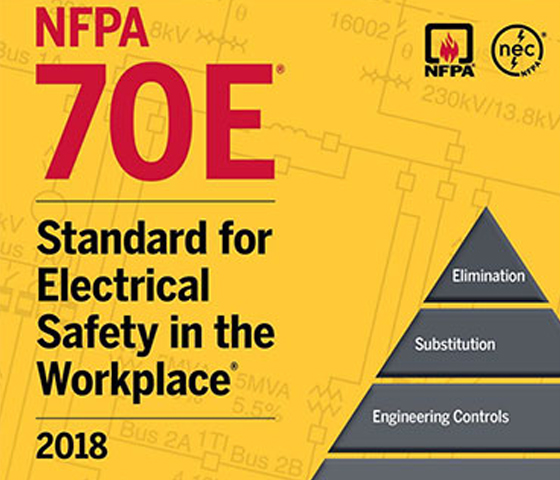Arc Flash Compliance
Arc Flash compliance is essentially governed by OSHA although their regulations do not specifically address arc flash and arc blast as hazards in the workplace, they can and will issue citations for workplaces not addressing these hazards. Though OSHA governs compliance with arc flash, they do not give any real insight how to safeguard against arc flash occurrence or proper personnel protection needed in the even of arc flash occurring. The proper procedures, PPE, and methods to safeguard against arc flash hazards are found within the NFPA 70E.
The NFPA 70E Requires The Following:
- A hazard risk assessment must be performed for all electrical equipment. This assessment should be documented and should identify the risk of both shock and arc flash hazards.
- Employers must provide proper training for personnel. The training must be in-the-classroom or on-the-job type and should make workers aware of the hazards of working with electricity and how to protect themselves from injury based upon the NFPA 70E.
- Workplaces must have safe work practices put in place to help protect workers. These safe work practices must be documented and audited to ensure employee compliance.
- All electrical equipment that meets the requirements for arc flash analysis must be properly labeled.
- Employees must be furnished with the proper PPE for their work tasks. This PPE should provide protection from both shock and arc flash hazards as required. The PPE should also meet ANSI and ASTM standards.
- The primary focus of the NFPA 70E is to put polices and procedure into place that will help to ensure worker safety when working on or near electrical power systems. Other added benefits could be reduced insurance premiums, reduction in workplace injuries, and even increased electrical system reliability.
- Every workplace should use the NFPA 70E as a reference point when it comes to electrical safety. Copies can be purchased from the NFPA website at a minimal cost, or the NFPA does allow access to their standards in an online reader form for free.

Electrically Safe Work Condition
At the heart of any electrical safety document or program is the establishment of an electrically safe work condition. The NFPA 70E is no exception. This concept is woven throughout the fabric of the document. The only way to eliminate all known hazards identified in the standard is to eliminate what is needed to produce them. That is energized electrical circuits. The following procedure should be followed to reach this safe work condition.
1. Determine all possible sources of electrical energy to the equipment.
2. Interrupt load current and open disconnecting devices for all sources.
3. Where possible, visually confirm that disconnecting devices are open.
4. Follow appropriate lockout/tag-out procedures.
5. Verify that equipment is de-energized using proper metering equipment. The procedure for this is a live test to ensure proper functioning, a dead test to verify the circuit is de-energized, and than another live test to further ensure there was no malfunction with the test equipment.
6. Use grounding devices and techniques where the possibility of stored energy or induced voltages exists.
The creation of an electrically safe work condition is the only sure way to eliminate the hazards of electricity. One thought to keep in mind throughout the process of creating an electrically safe work condition, is that the hazards of electricity are still present during the process. All applicable PPE and documentation should be in place until the electrically safe work condition is established.
This electrically safe work condition is so important that it is actually required for all situations where the limited approach boundary or the arc flash boundary are to be crossed by personnel. There are three exceptions to this requirement that are listed below:
When de-energizing electrical equipment poses a greater hazard to other personnel. Such examples are hazard ventilation systems, life support systems, etc…
De-energizing electrical equipment is infeasible due to design limitations, or task being performed. A great example of this would be troubleshooting electrical circuits. It is nearly impossible to troubleshoot a dead circuit.
The system voltage that is being accessed is less than 50V to ground.
Electrical Equipment Labeling Requirements
The electrical equipment labeling requirements found in the NFPA 70E have been updated in 2012 with much greater detail of what should be posted on the labels.
130.5(C) States:
The electrical equipment labeling requirements found in the NFPA 70E have been updated in 2012 with much greater detail of what should be posted on the labels.
- Available incident energy and the corresponding working distance
- Minimum arc rating of clothing
- Required level of PPE
- Date of the hazard analysis
- Highest Hazard/Risk category (HRC) for the equipment
- Nominal system voltage
- Arc flash boundary
The NEC 110.16 also covers the equipment types listed above without the detail of information required to be shown on the label. The NEC 110.16, does however make reference to the most recent NFPA 70E for more detail on labeling requirements.
Calculating Arc Flash Hazard Levels
In order to calculate arc flash hazards, an arc flash hazard analysis must be performed on a facility’s power system. This analysis is a detailed study of the power system based upon the calculation methods outlined in the NFPA 70E or IEEE 1584. This work should be performed by a qualified firm specializing in arc flash analysis and power systems studies, and should only be performed with commercial engineering software designed for power systems analysis.
In almost every instance this portion of NFPA 70E compliance is the most costly and time consuming for any company. It is however the most important part of the compliance effort. Without this analysis there could be no safety program detailing hazards, the training would be of no effect because the hazards levels would be unknown, and there would be no way to affectively choose the proper PPE.
Personal Protective Equipment
PPE comes in many shapes and sizes for electrical use. There is PPE specifically designed to protect workers from shock and electrocution hazards, as well as specific PPE for arc flash hazards as well. PPE for arc flash is flame resistant and arc-rated. This PPE must include the Arc Thermal Performance Value written in cal/cm2. To simplify the method of selecting the proper PPE, the NFPA 70E has created Hazard Risk Categories (HRC) to cover a range of hazard values. These HRC numbers provide a minimum level of protection to be worn. There are HRC’s ranging form “0” to “4” based upon the severity of the calculated hazard.
NFPA 70E Electrical Safety And Arc Flash Training
Article 110.2 of the NFPA 70E gives detail on the training requirements for arc flash. The NFPA 70E requires that training be in-the-classroom or on-the-job type of training and should be based upon the task of the individual worker. There is a differentiation of a qualified person and a non-qualified person. This qualification must be determined by the employer and the training of the individual should be based upon this qualification as well. Qualified workers should receive training in the dangers of electricity, selection of PPE, understanding of boundaries and limits of approach, establishing an electrically safe working condition, as well as other pertinent topics. Non-qualified individuals should be trained at a minimum to be aware of the hazards of electricity and to avoid hazardous areas and situations.
Specialization
EDS specializes in many different aspects of electrical training and engineering.
Affordable Price
All training courses are available in affordable prices.
Free Estimation
To get a free no obligation quote, please email us your details or call us and we will get back to you the same day.
